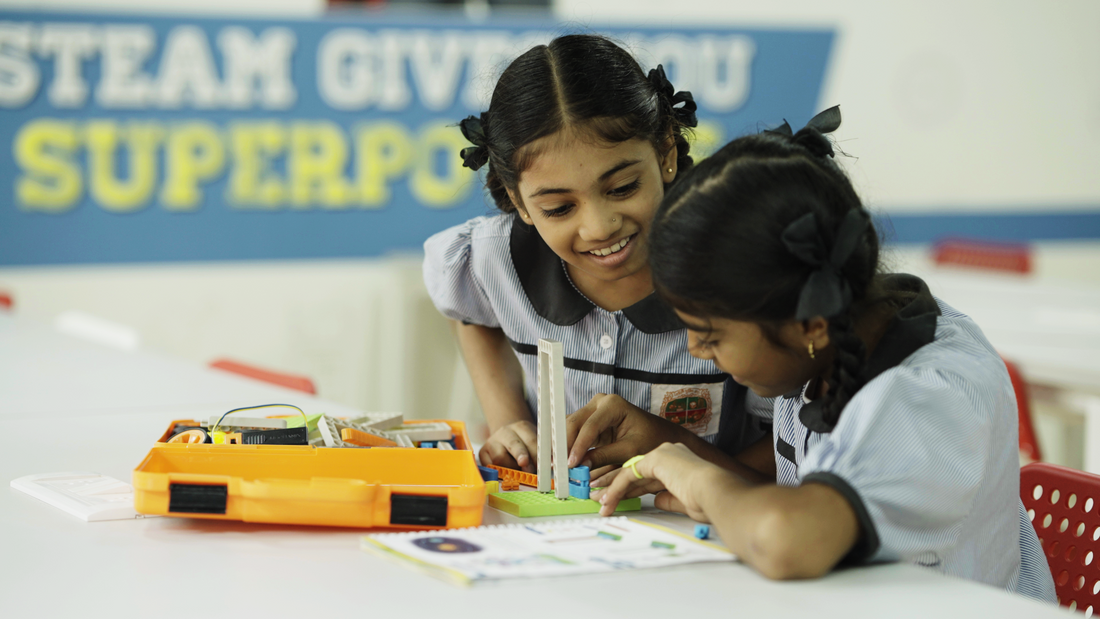
Challenges and Solutions in Implementing STEM Labs
Share

Establishing a STEM lab in school has long been an argumentative issue for many schools. Most likely as a result of the challenges that the overall setup provides.
By installing robotics labs in schools and involving students in hands-on learning with STEM kits, the intention is to create an interactive learning environment. Students here can tinker, build, and learn through experimentation. Now let's get into the main part:
Common Challenges in Implementing STEM Labs
1. The Right Products
Selecting the right products for a STEM lab in school is extremely important. Schools should search for tools that are intuitive and engaging for students. Many educational toys fail to strike the right balance. Either being too simplistic or overly complex. As a result, such innovative learning tools are frequently underutilized and disengaged.
Solution:
Find a company that can design the products after examining the technology that offers the most learning through Play. Someone who is well-established in the toy sector and can make educational STEM toys, such as Blix.
In addition to unplugged activities, educational toys with coding can help students understand STEM if they are intuitive and engaging. Blix provides high-quality of such STEM kits that use the Play technique to help students learn complicated ideas.
2. Curriculum Integration
We have a set education standard that has been implemented over the years. That is why it is a bit challenging to integrate STEAM labs with the existing educational system. Today's education system requires a revolutionary change to make room for more practical knowledge than bookish knowledge.
Solution:
Coming to Blix again, the curriculum here aligns with government-recognized educational standards. Concepts like force, power, voltage, and current are taught through practical activities, making theoretical concepts easier to understand and keeping students engaged. The curriculum is also designed to be self-sufficient. It allows students to learn independently so that the burden is less on teachers.
3. Teacher Training
A successful STEM or robotics lab setup requires teachers who are well-versed in STEM subjects and skilled in using the lab equipment. Unfortunately, many schools struggle to find educators with the necessary expertise.
Solution:
If you choose Blix, the team offers extensive support to teachers. Blix provides everything you need, including training sessions, simple instructional materials, continuing assistance, and after-sales support.
4. Budget Constraints
A STEM lab setup requires a large equipment investment. In addition, materials and infrastructure need to be taken care of. For many schools, STEM kits for schools, coding-based educational toys, and robotics lab sets can be expensive.
Solution:
The government is promoting STEM education these days. For this reason, Blix has partnered with organizations and governments to guarantee that its products are within the financial means of individuals from a wide range of socioeconomic backgrounds.
Blix recently provided funding for a lab in a Navi Mumbai municipal school. Blix products are very reasonably priced because they are exclusively manufactured in India.
5. Maintenance and Sustainability
The sustainability of STEM labs in school is another challenge many institutions face. Equipment needs to be durable and easily replaceable. Without proper maintenance, labs can quickly become obsolete or non-functional.
Solution:
Maintenance has always been a concern for schools. Blix's products are made from high-quality materials that can withstand extensive use. The majority of the components are designed to be reusable. Schools get the most out of their investment. In cases of breakage, replacement parts are affordable and readily available.
There undoubtedly are multiple benefits of establishing a STEM lab in a school. Students develop critical thinking and problem-solving skills. And these are needed the most in the 21st-century workforce. STEM labs prepare students for future careers in STEM fields. So, are you ready to shape the future of students?
